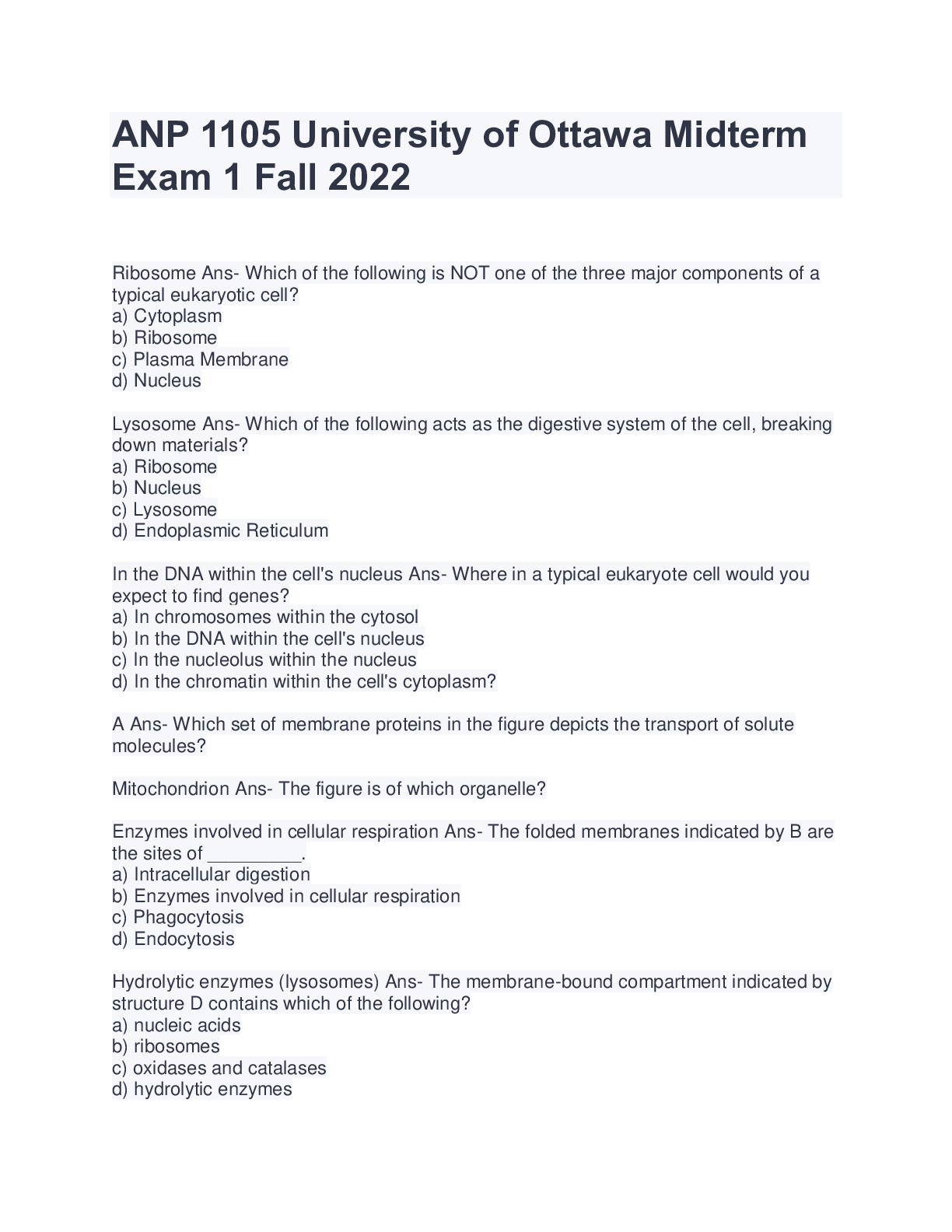Physiology > EXAM > EGC 6466 Exam 1 Fall 2020 - Central Texas College - A Grade (All)
EGC 6466 Exam 1 Fall 2020 - Central Texas College - A Grade
Document Content and Description Below
EGC 6466 Exam 1 Fall 2020 - Central Texas College Score for this quiz: 118 out of 120 Submitted Jul 29 at 7:12am This attempt took 54 minutes. Question 1 2 / 2 pts The lung is innervat... ed by the parasympathetic nervous system via which nerve? Correct! Vagus Phrenic Brachial Pectoral Fibers of the parasympathetic division of the autonomic nervous system (ANS) travel only in the vagus nerve to the lung. Question 2 2 / 2 pts What is the action of urodilatin? Urodilatin causes vasoconstriction of afferent arterioles. It causes vasodilation of the efferent arterioles. Urodilatin inhibits antidiuretic hormone secretion. Correct! It inhibits salt and water reabsorption. Urodilatin (a natriuretic peptide) inhibits sodium and water reabsorption from the medullary part of collecting duct, thereby producing diuresis. It is not involved in the actions described by the other options. Question 3 2 / 2 pts What is the direct action of atrial natriuretic hormone? Sodium retention Correct! Sodium excretion Water retention Water excretion Atrial natriuretic peptide (ANP) and brain natriuretic peptide (BNP) inhibit the secretion of renin, inhibit angiotensin-induced secretion of aldosterone, vasodilate the afferent and constrict the efferent glomerular arterioles, and inhibit sodium and water absorption by kidney tubules. The other actions are not a result of the atrial natriuretic hormone. Question 4 2 / 2 pts Which statement best describes a Schilling test? Correct! Administration of radioactive cobalamin and the measurement of its excretion in the urine to test for vitamin B12 deficiency Measurement of antigen-antibody immune complexes in the blood to test for hemolytic anemia Measurement of serum ferritin and total iron-binding capacity in the blood to test for iron deficiency anemia Administration of folate and measurement in 2 hours of its level in a blood sample to test for folic acid deficiency anemia. The Schilling test indirectly evaluates vitamin B12 absorption by administering radioactive B12 and measuring excretion in the urine. This selection is the only option that accurately describes a Schilling test. Question 5 2 / 2 pts Hemolytic disease of the newborn (HDN) can occur if the mother: Is Rh-positive and the fetus is Rh-negative Correct! Is Rh-negative and the fetus is Rh-positive Has type A blood and the fetus has type O Has type AB blood and the fetus has type B HDN can occur only if antigens on fetal erythrocytes differ from antigens on maternal erythrocytes. Maternal-fetal incompatibility exists only if the mother and fetus differ in ABO blood type or if the fetus is Rh-positive and the mother is Rh-negative. This erythrocyte incompatibility does not exist in any of the other options. Question 6 2 / 2 pts Which T-lymphocyte phenotype is the key determinant of childhood asthma? Cluster of differentiation (CD) 4 T-helper Th1 lymphocytes Correct! CD4 T-helper Th2 lymphocytes CD8 cytotoxic T lymphocytes Memory T lymphocytes Asthma develops because the Th2 response (in which CD4 T-helper cells produce specific cytokines, such as interleukin [IL]–4, IL-5, and IL-13) promotes an atopic and allergic response in the airways. This selection is the only option that accurately identifies the appropriate T-lymphocyte phenotype. Question 7 2 / 2 pts Perceived stress elicits an emotional, anticipatory response that begins where? Prefrontal cortex Anterior pituitary Correct! Limbic system Hypothalamus Perceived stressors elicit an anticipatory response that begins in the limbic system of the brain, the only option responsible for emotions and cognition. Question 8 2 / 2 pts Hypersensitivity is best defined as a(an): Disturbance in the immunologic tolerance of self-antigens Immunologic reaction of one person to the tissue of another person Correct! Altered immunologic response to an antigen that results in disease Undetectable immune response in the presence of antigens Hypersensitivity is an altered immunologic response to an antigen that results in disease or damage to the host. The other options are not accurate definitions of hypersensitivity. Question 9 2 / 2 pts It has been determined that a tumor is in stage 2. What is the meaning of this finding? Cancer is confined to the organ of origin. Cancer has spread to regional structures. Correct! Cancer is locally invasive. Cancer has spread to distant sites Cancer confined to the organ of origin is stage 1; cancer that is locally invasive is stage 2; cancer that has spread to regional structures, such as the lymph nodes, is stage 3; and cancer that has spread to distant sites, such as a liver cancer spreading to the lung or a prostate cancer spreading to bone, is stage 4. Question 10 2 / 2 pts An infant has a loud, harsh, holosystolic murmur and systolic thrill that can be detected at the left lower sternal border that radiates to the neck. These clinical findings are consistent with which congenital heart defect? Atrial septal defect (ASD) Correct! Ventricular septal defect (VSD) Patent ductus arteriosus (PDA) Atrioventricular canal (AVC) defect On physical examination, a loud, harsh, holosystolic murmur and systolic thrill can be detected at the left lower sternal border. The intensity of the murmur reflects the pressure gradient across the VSD. An apical diastolic rumble may be present with a moderate-to-large defect, reflecting increased flow across the mitral valve. The presentations of the other congenital heart defects are not consistent with the described symptoms. Question 11 2 / 2 pts Which statement concerning exotoxins is true? Exotoxins are contained in cell walls of gram-negative bacteria. Exotoxins are released during the lysis of bacteria. Exotoxins are able to initiate the complement and coagulation cascades. Correct! Exotoxins are released during bacterial growth. Exotoxins are proteins released during bacterial growth. The other options are not true of exotoxins. Question 12 2 / 2 pts The function of the foramen ovale in a fetus allows what to occur? Correct! Right-to-left blood shunting Left-to-right blood shunting Blood flow from the umbilical cord Blood flow to the lungs The nonfused septum secundum and ostium secundum result in the formation of a flapped orifice known as the foramen ovale, which allows the right-to-left shunting necessary for fetal circulation. The foramen ovale is not involved in the blood flow described by the other options. Question 13 2 / 2 pts Which laboratory test is considered adequate for an accurate and reliable diagnosis of gonococcal urethritis in a symptomatic man? Ligase chain reaction (LCR) Correct! Gram-stain technique Polymerase chain reaction (PCR) DNA testing Microscopic evaluation of Gram-stained slides of clinical specimens is deemed positive for Neisseria gonorrhoeae if gram-negative diplococci with the typical “kidney bean” morphologic appearance are found inside polymorphonuclear leukocytes. Such a finding is considered adequate for the diagnosis of gonococcal urethritis in a symptomatic man. The other options are not relevant to the diagnosis of this condition. Question 14 2 / 2 pts Which manifestations of vasoocclusive crisis are associated with sickle cell disease (SCD) in infants? Atelectasis and pneumonia Correct! Edema of the hands and feet Stasis ulcers of the hands, ankles, and feet Splenomegaly and hepatomegaly Symmetric, painful swelling of the hands and feet (hand-foot syndrome) caused by infarction in the small vessels of the extremities is often the initial manifestation of SCD in infants. This selection is the only option that accurately identifies the manifestations of a vasoocclusive crisis associated with SCD in infancy. Question 15 2 / 2 pts Which statement concerning benign tumors is true? The resulting pain is severe. Benign tumors are not encapsulated. Benign tumors are fast growing. Correct! The cells are well-differentiated. A benign tumor is well-differentiated with its tissue appearing similar to the tissue from which it arose. The other options are characteristic of a malignant tumor. Question 16 2 / 2 pts Which primary characteristic is unique for the immune response? The immune response is similar each time it is activated. Correct! The immune response is specific to the antigen that initiates it. The response to a specific pathogen is short term. The response is innate, rather than acquired. Unlike inflammation, which is nonspecifically activated by cellular damage and pathogenic microorganisms, the immune response is primarily designed to afford long-term specific protection (i.e., immunity) against particular invading microorganisms; that is, it has a memory function. The other options are not unique characteristics of the immune response. Question 17 2 / 2 pts Which criterion is used to confirm a diagnosis of asthma in an 8-year-old child? Parental history of asthma Serum testing that confirms increased immunoglobulin E (IgE) and eosinophil levels Correct! Reduced expiratory flow rates confirmed by spirometry testing Improvement on a trial of asthma medication Confirmation of the diagnosis of asthma relies on pulmonary function testing using spirometry, which can be accomplished only after the child is 5 to 6 years of age. Reduced expiratory flow rates that are reversible in response to an inhaled bronchodilator would be characteristic abnormalities. For younger children, an empiric trial of asthma medications is commonly initiated. The remaining options are major historical and physical factors that contribute but do not confirm the diagnosis of asthma in children. Question 18 0 / 2 pts Where are antibodies produced? Helper T lymphocytes Thymus gland Correct Answer Plasma cells You Answered Bone marrow An antibody or immunoglobulin is a serum glycoprotein produced only by plasma cells in response to a challenge by an immunogen. Question 19 2 / 2 pts How much urine accumulates in the bladder before the mechanoreceptors sense bladder fullness? 75 to 100 ml 100 to 150 ml Correct! 250 to 300 ml 350 to 400 ml When the bladder accumulates 250 to 300 ml of urine, it contracts and the internal urethral sphincter relaxes through activation of the spinal reflex arc (known as the micturition reflex). Question 20 2 / 2 pts Which disorder results in decreased erythrocytes and platelets with changes in leukocytes and has clinical manifestations of pallor, fatigue, petechiae, purpura, bleeding, and fever? Idiopathic thrombocytopenic purpura (ITP) Correct! Acute lymphocytic leukemia (ALL) Non-Hodgkin lymphoma (NHL) Iron deficiency anemia (IDA) Pallor, fatigue, petechiae, purpura, bleeding, and fever are generally present with the most common symptoms reflecting the consequence of bone marrow failure, which results in decreased red blood cells and platelets and changes in white blood cells. This selection is the only option that correctly identifies the disease with the symptoms described. Question 21 2 / 2 pts Carcinoma in situ is characterized by which changes? Cells have broken through the local basement membrane. Cells have invaded immediate surrounding tissue. Correct! Cells remain localized in the glandular or squamous cells. Cellular and tissue alterations indicate dysplasia. Carcinoma in situ (CIS) refers to preinvasive epithelial malignant tumors of glandular or squamous cell origin. These early stage cancers are localized to the epithelium and have not broken through the local basement membrane or invaded the surrounding tissue. Dysplasia refers to changes in mature cell structure. Question 22 2 / 2 pts What is the life span of platelets (in days)? Correct! 10 30 90 120 A platelet circulates for approximately 10 days and ages. Macrophages of the mononuclear phagocyte system, mostly in the spleen, remove platelets. Question 23 2 / 2 pts What is the primary cause of respiratory distress syndrome (RDS) of the newborn? Immature immune system Small alveoli Correct! Surfactant deficiency Anemia RDS is primarily caused by surfactant deficiency and secondarily by a deficiency in alveolar surface area for gas exchange. None of the other options are related to the cause of RDS. Question 24 2 / 2 pts What is the life span of an erythrocyte (in days)? 20 to 30 60 to 90 Correct! 100 to 120 200 to 240 Because it cannot undergo mitotic division, the erythrocyte has a limited life span of approximately 120 days. Question 25 2 / 2 pts Low plasma albumin causes edema as a result of a reduction in which pressure? Capillary hydrostatic Interstitial hydrostatic Correct! Plasma oncotic Interstitial oncotic Losses or diminished production of plasma albumin is the only option that contributes to a decrease in plasma oncotic pressure. Question 26 2 / 2 pts Which blood cell type is elevated at birth but decreases to adult levels during the first year of life? Correct! Monocytes Platelets Neutrophils Lymphocytes Only monocyte counts are high in the first year of life and then decrease to adult levels. Question 27 2 / 2 pts Which organ is stimulated during the alarm phase of the general adaptation syndrome (GAS)? Adrenal cortex Correct! Hypothalamus Anterior pituitary Limbic system The alarm phase of the GAS begins when a stressor triggers the actions of the hypothalamus and the sympathetic nervous system (SNS) (see Figure 11-1). The other organs are not stimulated by the alarm phase of GAS. Question 28 2 / 2 pts Phagocytosis involves neutrophils actively attacking, engulfing, and destroying which microorganisms? Correct! Bacteria Fungi Viruses Yeasts Invasion is the direct confrontation with an individual’s primary defense mechanisms against only bacteria, which include the complement system, antibodies, and phagocytes, such as neutrophils and macrophages. Question 29 2 / 2 pts What part of the kidney controls renal blood flow, glomerular filtration, and renin secretion? Macula densa Visceral epithelium Correct! Juxtaglomerular apparatus (JGA) Filtration slits Control of renal blood flow, glomerular filtration, and renin secretion occur at the JGA. Together, the juxtaglomerular cells and macula densa cells form the JGA. The control of renal blood flow, glomerular filtration, and renin secretion is not directed by any of the other options. Question 30 2 / 2 pts The risk for respiratory distress syndrome (RDS) decreases for premature infants when they are born between how many weeks of gestation? 16 and 20 20 and 24 24 and 30 Correct! 30 and 36 Surfactant is secreted into fetal airways between 30 and 36 weeks. The other options are not true regarding the timeframe when the risk for RDS decreases. Question 31 2 / 2 pts What is the functional unit of the kidney called? Glomerulus Correct! Nephron Collecting duct Pyramid The nephron is the functional unit of the kidney. Although the other options are also located in the kidney, they are not its functional units. Question 32 2 / 2 pts Which hepatitis virus is known to be sexually transmitted? A Correct! B C D Only hepatitis B virus (HBV) is known to be sexually transmitted. Question 33 2 / 2 pts Which statement is true concerning the IgM? Correct! IgM is the first antibody produced during the initial response to an antigen. IgM mediates many common allergic responses. IgM is the most abundant class of immunoglobulins. IgM is capable of crossing the human placenta. Typically, IgM is produced first (primary immune response), followed by IgG against the same antigen. The other options are not true statements regarding IgM. Question 34 2 / 2 pts Apoptosis is a(an): Correct! Normal mechanism for cells to self-destruct when growth is excessive Antigrowth signal activated by the tumor-suppressor gene Rb Mutation of cell growth stimulated by the TP53 gene Transformation of cells from dysplasia to anaplasia Normal cells have a mechanism that causes them to self-destruct when growth is excessive and cell cycle checkpoints have been ignored. Diverse stimuli, including normal development and excessive growth, trigger this self-destruct mechanism, called apoptosis. The remaining options do not describe apoptosis. Question 35 2 / 2 pts What are the abnormalities in cytokines found in children with cystic fibrosis (CF)? Deficit of interleukin (IL)–1 and an excess of IL-4, IL-12, and interferon-alpha (IFN-α) Deficit of IL-6 and an excess of IL-2, IL-8, and granulocyte colony-stimulating factor (G-CSF) Correct! Deficit of IL-10 and an excess of IL-1, IL-8, and TNF-α Deficit of IL-3 and an excess of IL-14, IL-24, and colony-stimulating factor (CSF) Abnormal cytokine profiles have been documented in CF airway fluids, including deficient IL-10 and excessive IL-1, IL-8, and TNF-α, all changes conducive to promoting inflammation. This selection is the only option that accurately identifies the abnormalities in cytokines observed in children with CF. Question 36 2 / 2 pts Research supports the premise that exercise has a probable impact on reducing the risk of which cancer? Liver Endometrial Stomach Correct! Colon The World Cancer Research Fund summarizes the effects as convincingfor cancers of the colon and probable for postmenopausal breast cancer and endometrial cancer. The relationship is not supported for the remaining options. Question 37 2 / 2 pts Why is nasal congestion a serious threat to young infants? Correct! Infants are obligatory nose breathers. Their noses are small in diameter. Infants become dehydrated when mouth breathing. Their epiglottis is proportionally greater than the epiglottis of an adult’s. Infants up to 2 to 3 months of age are obligatory nose breathers and are unable to breathe in through their mouths. Nasal congestion is therefore a serious threat to a young infant. This selection is the only option that accurately describes why nasal congestion is a serious threat to young infants. Question 38 2 / 2 pts Between which months of age does sudden infant death syndrome (SIDS) most often occur? 0 and 1 Correct! 2 and 4 5 and 6 6 and 7 The incidence of SIDS is low during the first month of life but sharply increases in the second month of life, peaking at 2 to 4 months and is unusual after 6 months of age. Question 39 2 / 2 pts In which primary immune deficiency is there a partial-to-complete absence of T-cell immunity? Bruton disease Correct! DiGeorge syndrome Reticular dysgenesis Adenosine deaminase deficiency The principal immunologic defect in DiGeorge syndrome is the partial or complete absence of T-cell immunity. The other options are not the result of either a partial or complete absence of T-cell immunity. Question 40 2 / 2 pts Blood vessels of the kidneys are innervated by the: Vagus nerve Correct! Sympathetic nervous system Somatic nervous system Parasympathetic nervous system The blood vessels of the kidney are innervated by the sympathetic noradrenergic fibers that cause arteriolar vasoconstriction and reduce renal blood flow. The other options are not involved in this process. Question 41 2 / 2 pts An individual is more susceptible to infections of mucous membranes when he or she has a seriously low level of which immunoglobulin antibody? IgG IgM Correct! IgA IgE The IgA molecules found in bodily secretions are dimers anchored together through a J-chain and secretory piece. This secretory piece is attached to the IgA antibodies inside the mucosal epithelial cells and may function to protect these immunoglobulin antibodies against degradation by enzymes also found in the secretions, thus decreasing the risk of infections in the mucous membrane. The other options do not accurately identify the immunoglobulin antibody involved in mucous membrane infections. Question 42 2 / 2 pts Which term is used to identify the movement of gas and air into and out of the lungs? Perfusion Correct! Ventilation Respiration Diffusion Of the options available, ventilation is the only term used to identify the mechanical movement of gas or air into and out of the lungs. Question 43 2 / 2 pts What is the first stage in the infectious process? Invasion Correct! Colonization Spread Multiplication From the perspective of the microorganisms that cause disease, the infectious process undergoes four separate stages of progression: (1) colonization, (2) invasion, (3) multiplication, and (4) spread. Question 44 2 / 2 pts What process allows the kidney to respond to an increase in workload? Glomerular filtration Secretion of 1,25-dihydroxyvitamin D3 Increased heart rate Correct! Compensatory hypertrophy Compensatory hypertrophy allows the kidney to respond to an increase in workload throughout life. The remaining options are not relevant to accommodating an increased workload. Question 45 2 / 2 pts Which congenital heart defects occur in trisomy 13, trisomy 18, and Down syndrome? Coarctation of the aorta (COA) and pulmonary stenosis (PS) Tetralogy of Fallot and persistent truncus arteriosus Atrial septal defect (ASD) and dextrocardia Correct! Ventricular septal defect (VSD) and patent ductus arteriosus (PDA) Congenital heart defects that are related to dysfunction of trisomy 13, trisomy 18, and Down syndrome include VSD and PDA (see Table 33-2). The other defects are not associated with dysfunction of trisomy 13, trisomy 18, and Down syndrome. Question 46 2 / 2 pts What is the trigone? A smooth muscle that comprises the orifice of the ureter The inner mucosal lining of the kidneys Correct! A smooth triangular area between the openings of the two ureters and the urethra One of the three divisions of the loop of Henle The trigone is a smooth triangular area lying between the openings of thetwo ureters and the urethra. The other options do not accurately identify the trigone. Question 47 2 / 2 pts The coronary ostia are located in the: Left ventricle Aortic valve Coronary sinus Correct! Aorta Coronary arteries receive blood through openings in the aorta, called the coronary ostia. Question 48 2 / 2 pts What is the chief predisposing factor for respiratory distress syndrome (RDS) of the newborn? Low birth weight Alcohol consumption during pregnancy Correct! Premature birth Smoking during pregnancy RDS of the newborn, also known as hyaline membrane disease (HMD), is a major cause of morbidity and mortality in premature newborns. None of the other options are considered the chief predisposing factors for RDS. Question 49 2 / 2 pts The most common site of metastasis for a patient diagnosed with prostate cancer is which location? Correct! Bones Brain Bladder Kidney The bone, especially the lumbar spine area, is the most common metastasis site for prostate cancer. Question 50 2 / 2 pts Which of the following is classified as a megaloblastic anemia? Iron deficiency Correct! Pernicious Sideroblastic Hemolytic Pernicious anemia is the most common type of megaloblastic anemia. The remaining options are not classified as megaloblastic anemias. Question 51 2 / 2 pts The glomerular filtration rate is directly related to which factor? Correct! Perfusion pressure in the glomerular capillaries Diffusion rate in the renal cortex Diffusion rate in the renal medulla Glomerular active transport The filtration of the plasma per unit of time is known as the glomerular filtration rate (GFR), which is directly related to only the perfusion pressure in the glomerular capillaries. Question 52 2 / 2 pts In a normal, nonmutant state, an oncogene is referred to as a: Basal cell Target cell Caretaker gene Correct! Proto-oncogene In its normal nonmutant state, an oncogene is referred to as a proto-oncogene. The other options are not terms used to identify a nonmutant oncogene. Question 53 2 / 2 pts What is the most common cause of iron deficiency anemia (IDA)? Decreased dietary intake Correct! Chronic blood loss Vitamin deficiency Autoimmune disease The most common cause of IDA in well-developed countries is pregnancy and chronic blood loss. Question 54 2 / 2 pts What effect do natriuretic peptides have during heart failure when the heart dilates? Stimulates antidiuretic hormones. Inhibits antidiuretic hormones. Stimulates renin and aldosterone. Correct! Inhibits renin and aldosterone. Natriuretic peptides inhibit renin and aldosterone during heart failure when the heart dilates. These make up a group of peptide hormones, including atrial natriuretic peptide (ANP), secreted from myocardial cells in the atria and brain natriuretic peptide (BNP) secreted from myocardial cells in the cardiac ventricles. When the heart dilates during volume expansion or heart failure, ANP and BNP inhibit sodium and water absorption by kidney tubules, inhibit the secretion of renin and aldosterone, vasodilate the afferent arterioles, and constrict the efferent arterioles. The result is increased urine formation, leading to decreased blood volume and blood pressure. Question 55 2 / 2 pts What is the major concern regarding the treatment of gonococci infections? Correct! Development of antibiotic resistance Changes in virulence Changes in pathogenicity Mutations into different strains Several types of drug-resistant strains have been identified; they are penicillinase-producing Neisseria gonorrhoeae (PPNG), which is resistant to penicillin; tetracycline-resistant N. gonorrhoeae (TRNG), which is resistant to tetracycline; chromosomal control of mechanisms of resistance of N. gonorrhoeae (CMRNG), which is resistant to penicillin and tetracycline; and increasingly a fluoroquinolone-resistant N. gonorrhoeae (QRNG). The other options are not major concerns. Question 56 2 / 2 pts Immunoglobulin E (IgE) is associated with which type of hypersensitivity reaction? Correct! I II III IV Hypersensitivity reactions have been divided into four distinct types: type I (IgE-mediated) hypersensitivity reactions, type II (tissue-specific) hypersensitivity reactions, type III (immune complex–mediated) hypersensitivity reactions, and type IV (cell-mediated) hypersensitivity reactions. Question 57 2 / 2 pts Which cytokines initiate the production of corticotropin-releasing hormone (CRH)? Correct! IL–1 and IL-6 IL-2 and TNF-α IFN and IL-12 TNF-ß and IL-4 Although a number of stress factors initiate the production of CRH, of the options available, only high levels of IL-1 and IL-6 initiate such a response. Question 58 2 / 2 pts What is the primary site for uncomplicated local gonococci infections in men? Epididymis Lymph nodes Correct! Urethra Prostate Uncomplicated local infections are observed primarily as urethral infections in men. Question 59 2 / 2 pts Continuous increases in left ventricular filing pressures result in which disorder? Mitral regurgitation Mitral stenosis Correct! Pulmonary edema Jugular vein distention Pressure changes are important because increased left ventricular filling pressures back up into the pulmonary circulation, where they force plasma out through vessel walls, causing fluid to accumulate in lung tissues (pulmonary edema). This selection is the only option that accurately identifies the disorder described in the question. Question 60 2 / 2 pts Where in the respiratory tract do the majority of foreign objects aspirated by children finally lodge? Trachea Left lung Correct! Bronchus Bronchioles Approximately 75% of aspirated foreign bodies lodge in a bronchus. The other options are not locations where children aspirate the majority of foreign objects. [Show More]
Last updated: 1 month ago
Preview 1 out of 42 pages

Reviews( 1 )

by alison · 3 years ago
Document information
Connected school, study & course
About the document
Uploaded On
Dec 04, 2020
Number of pages
42
Written in
Additional information
This document has been written for:
Uploaded
Dec 04, 2020
Downloads
3
Views
131


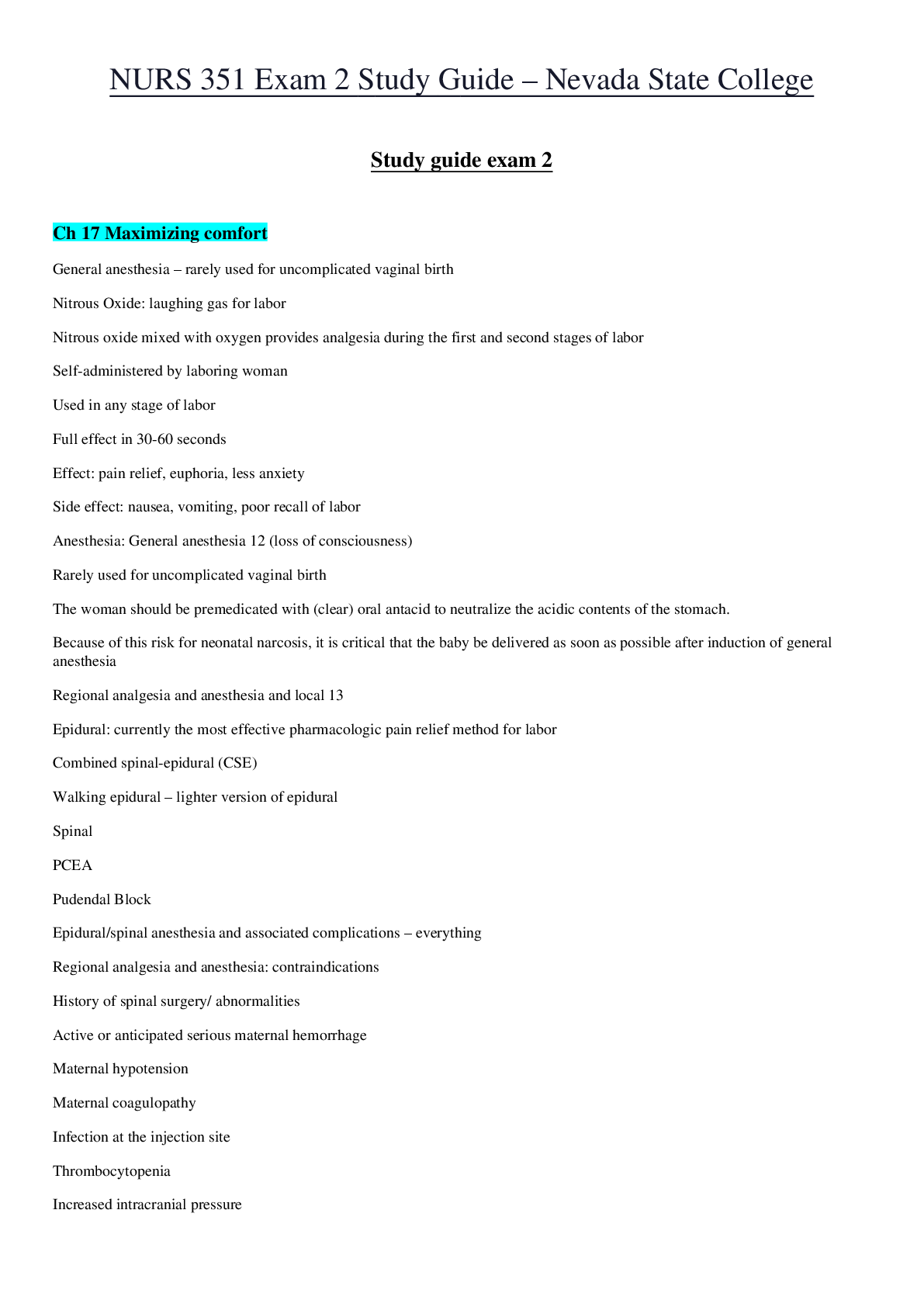
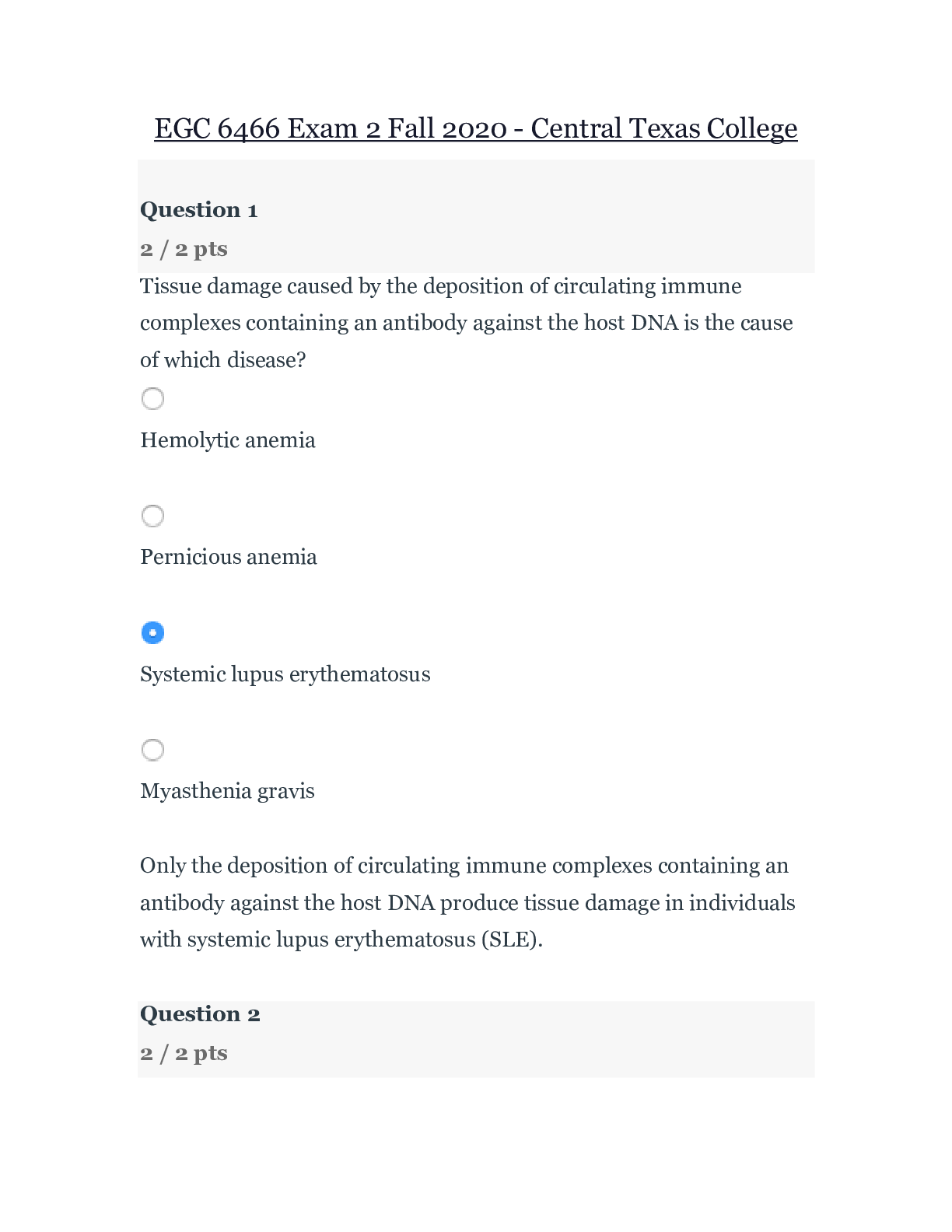
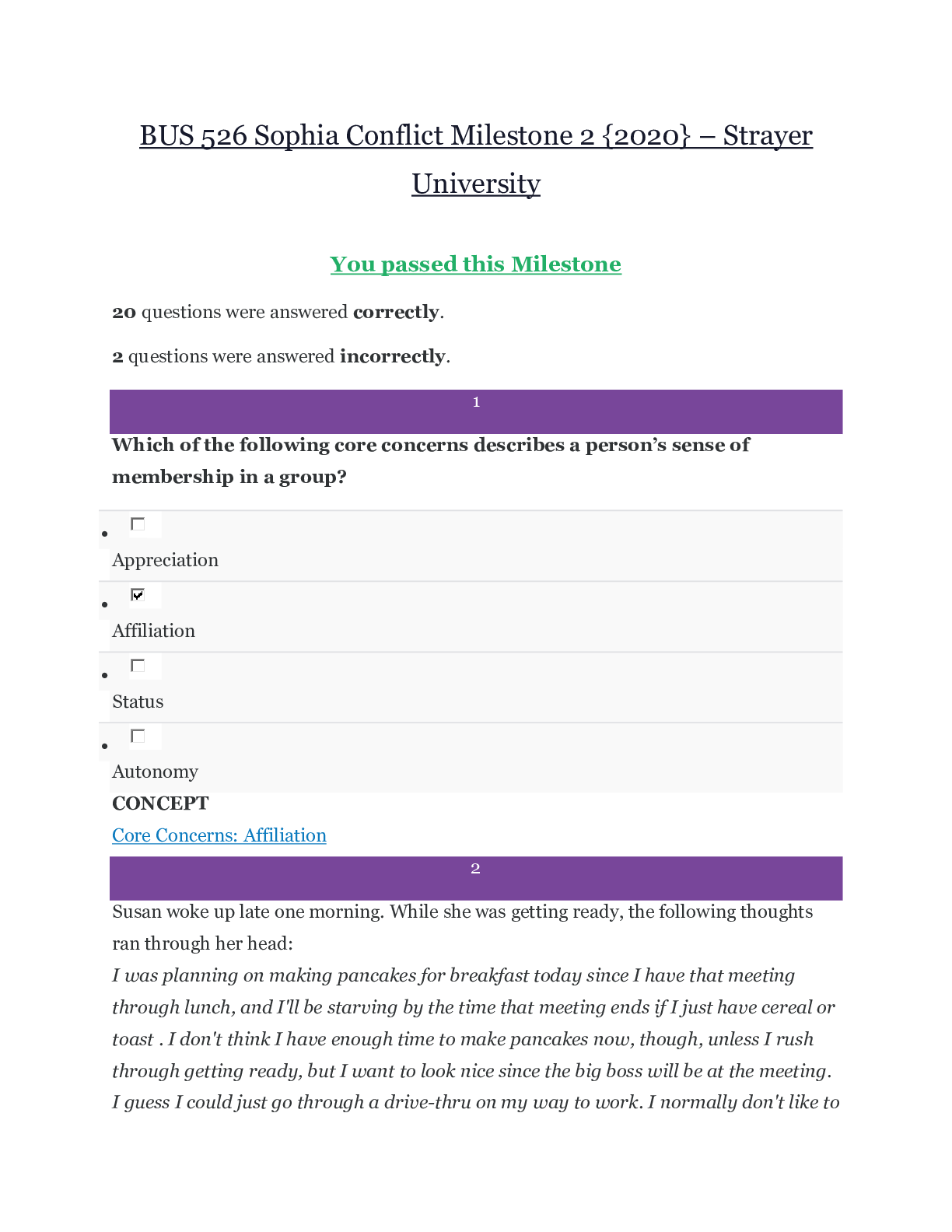
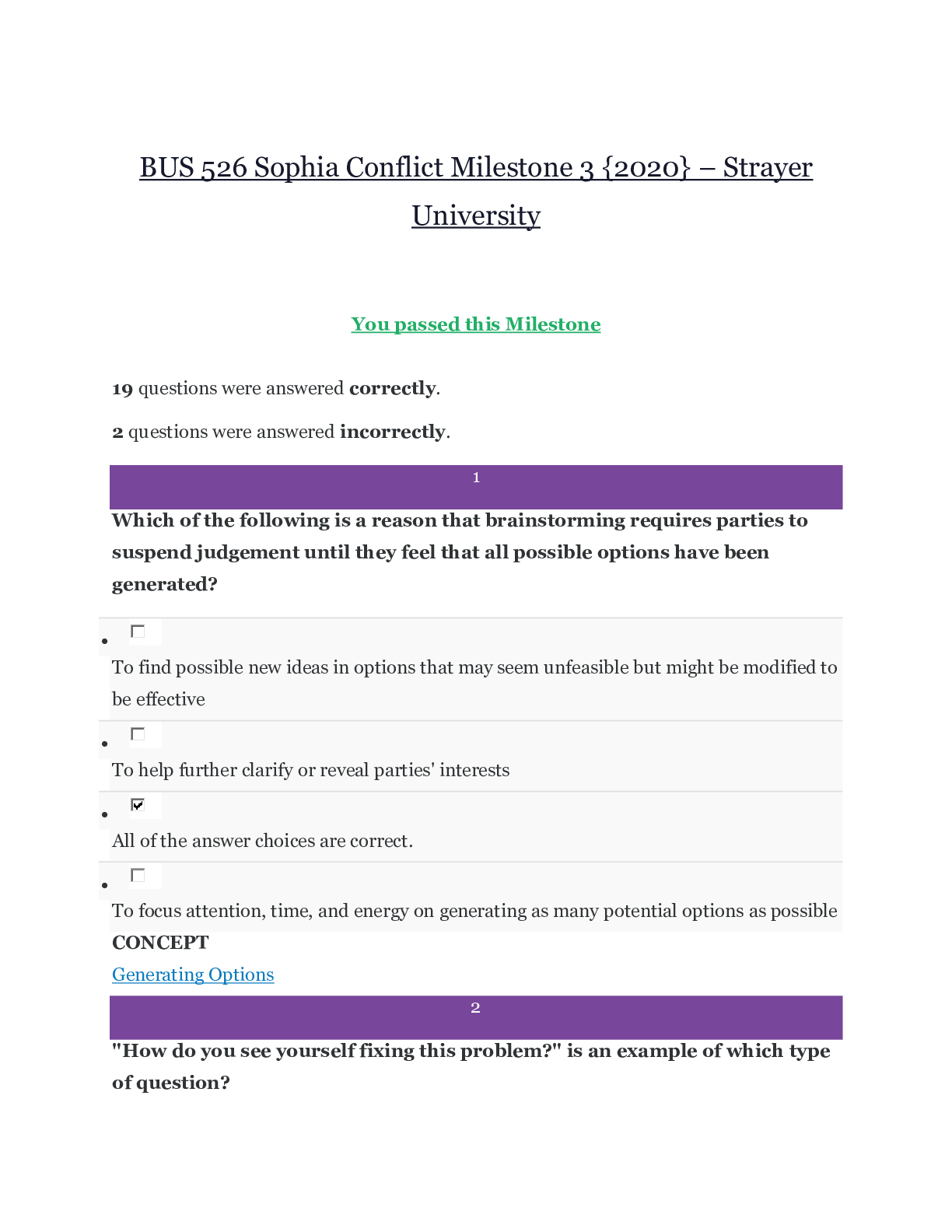



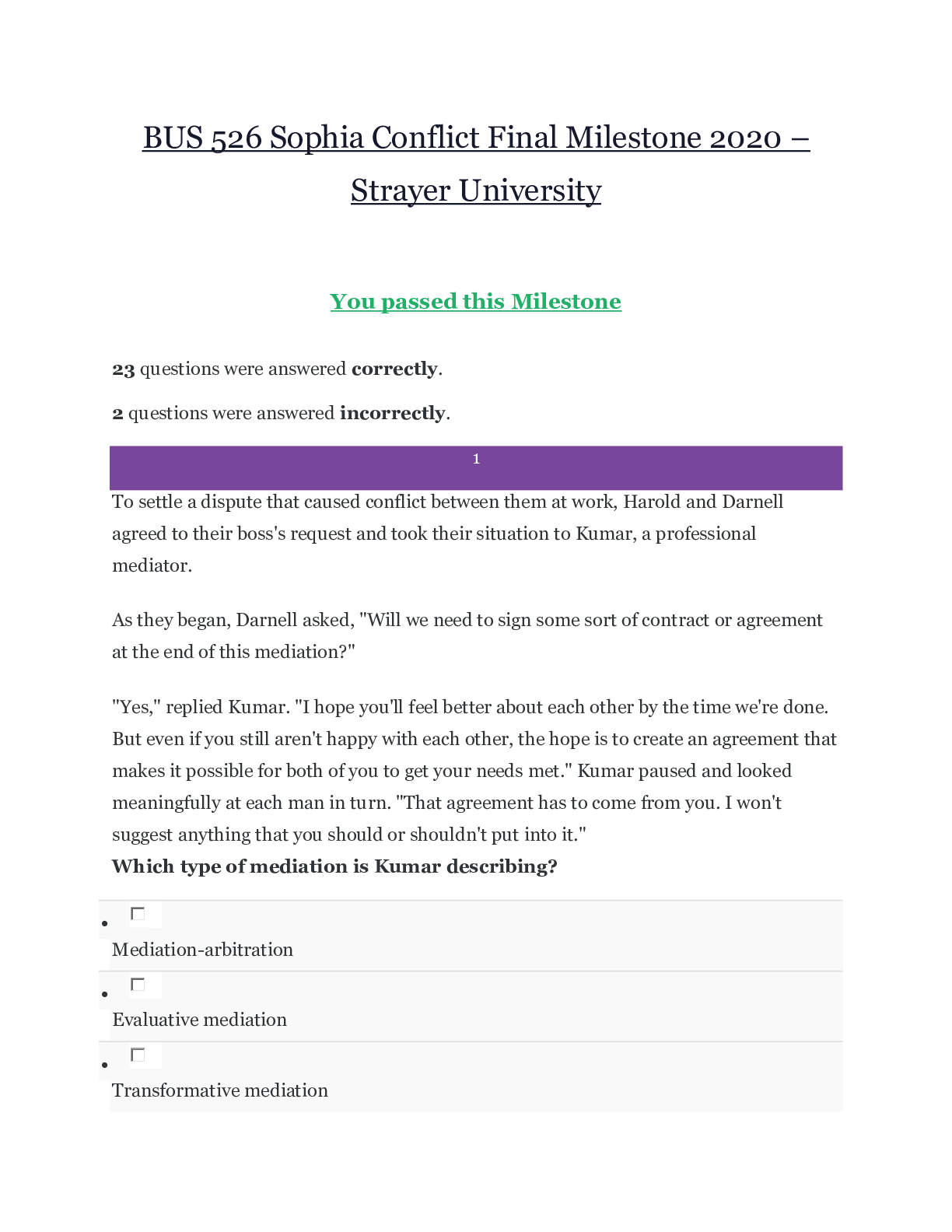

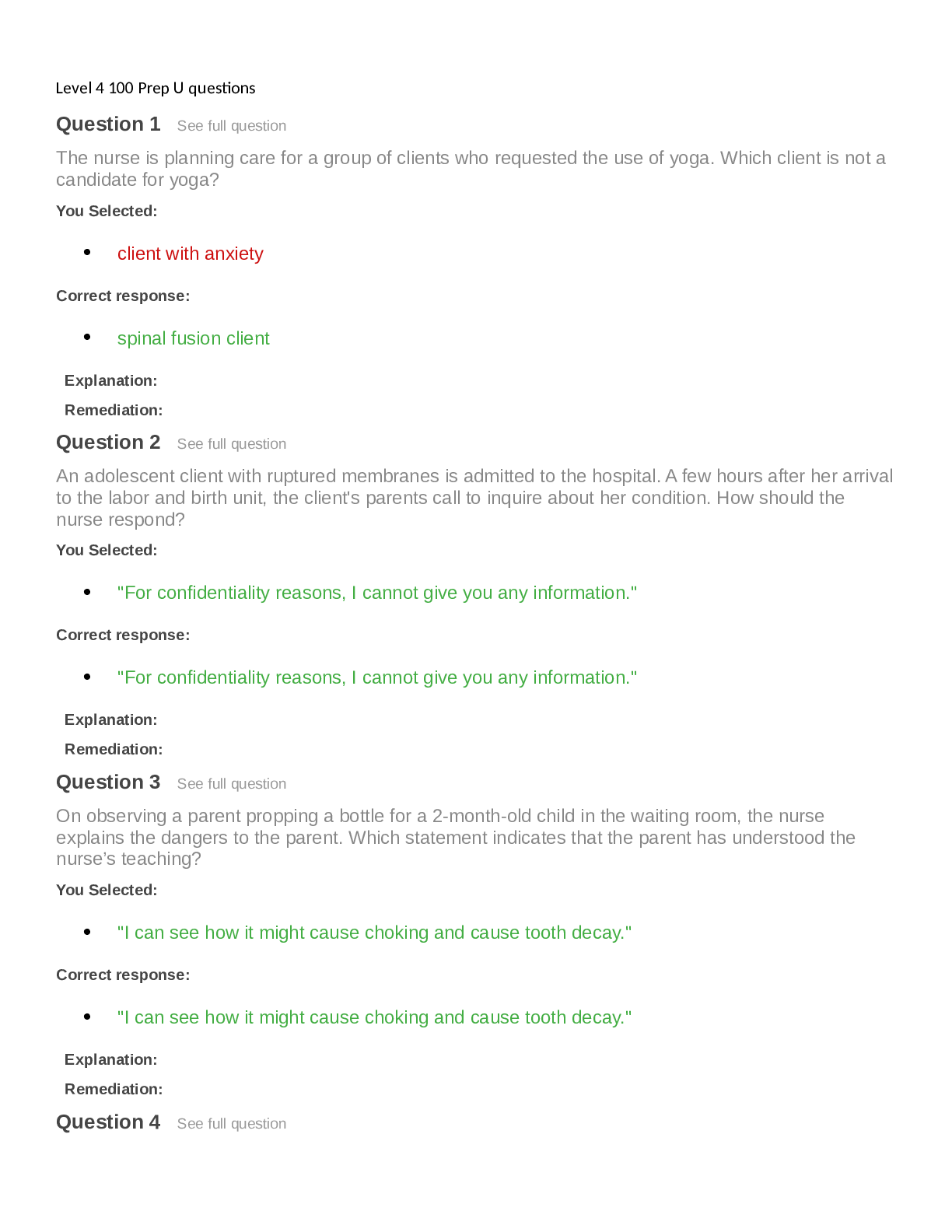
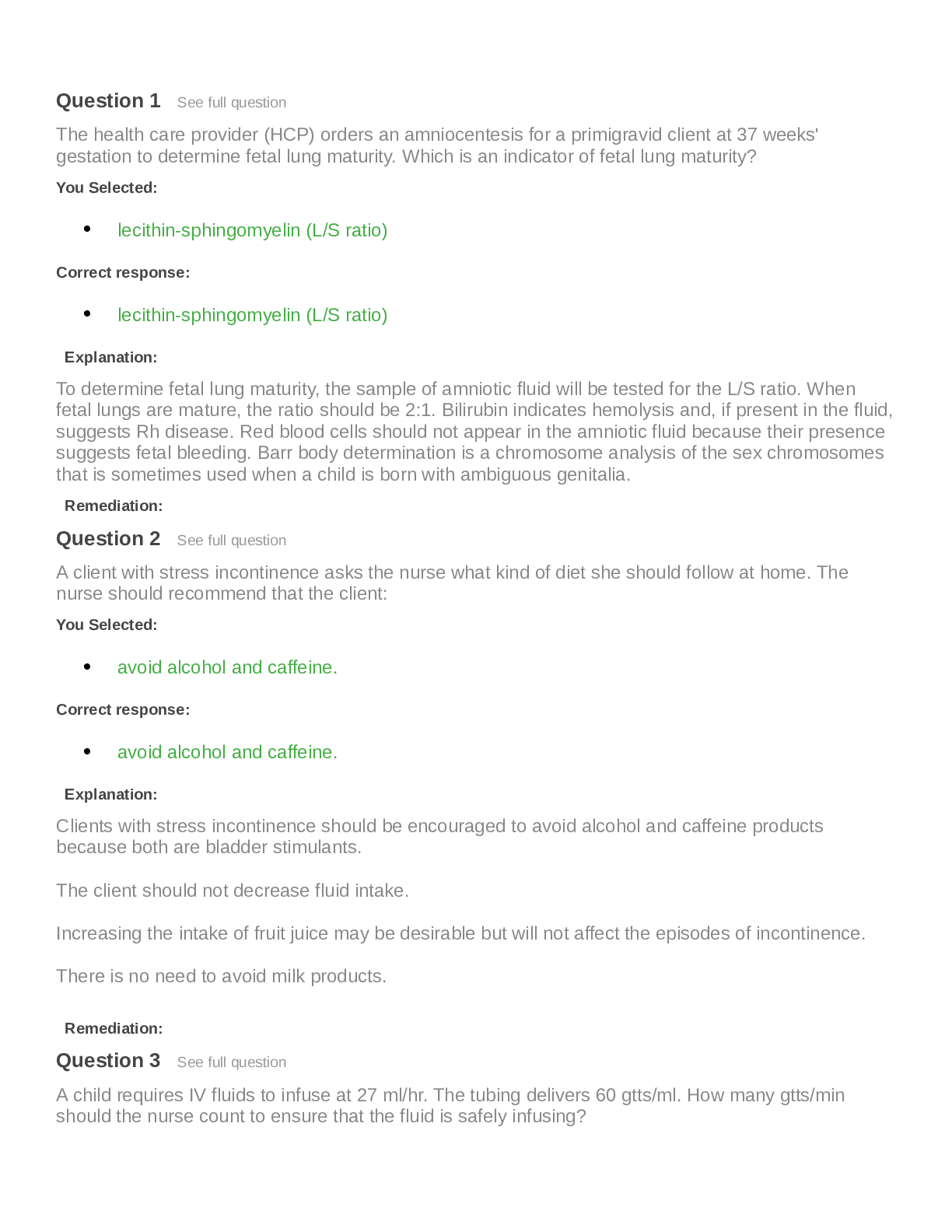

.png)

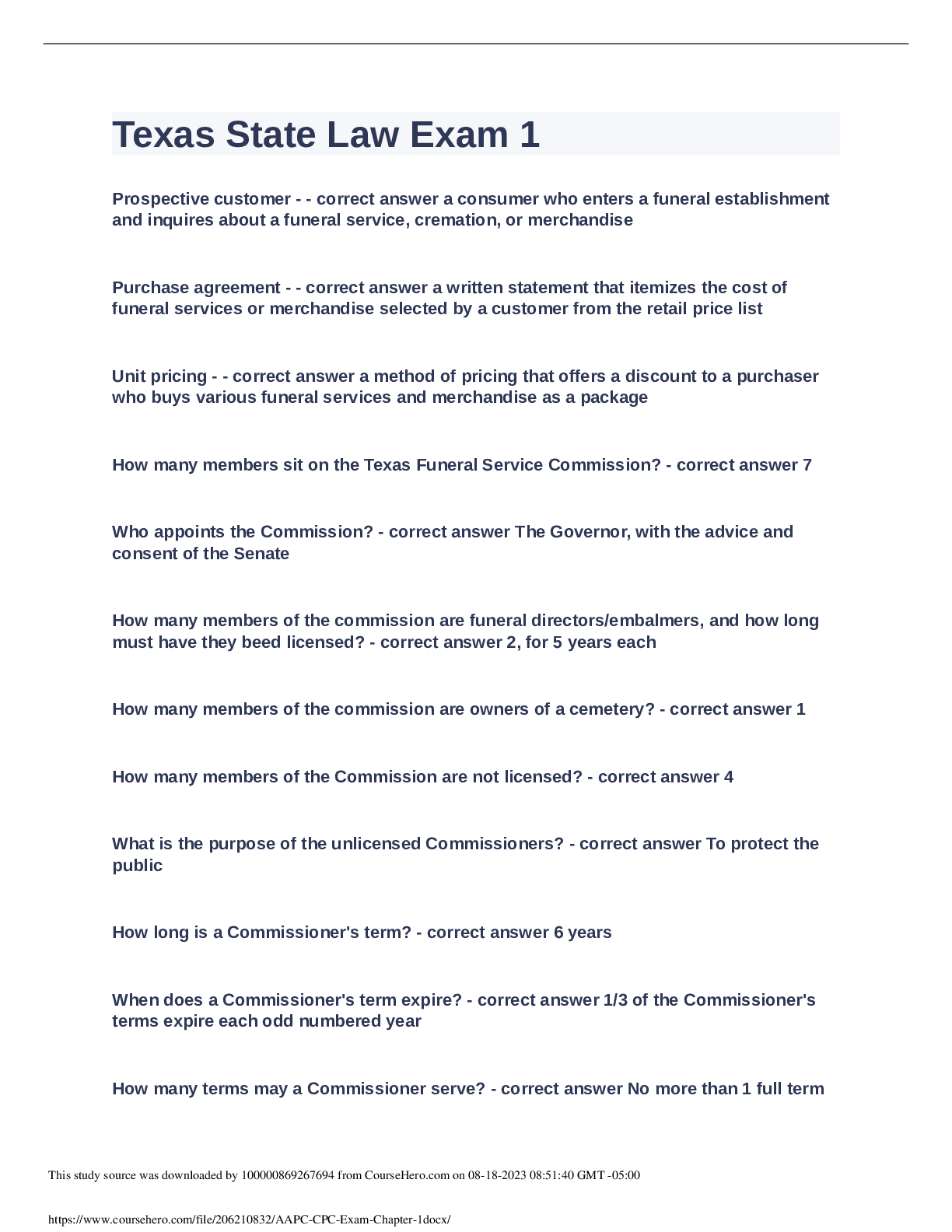

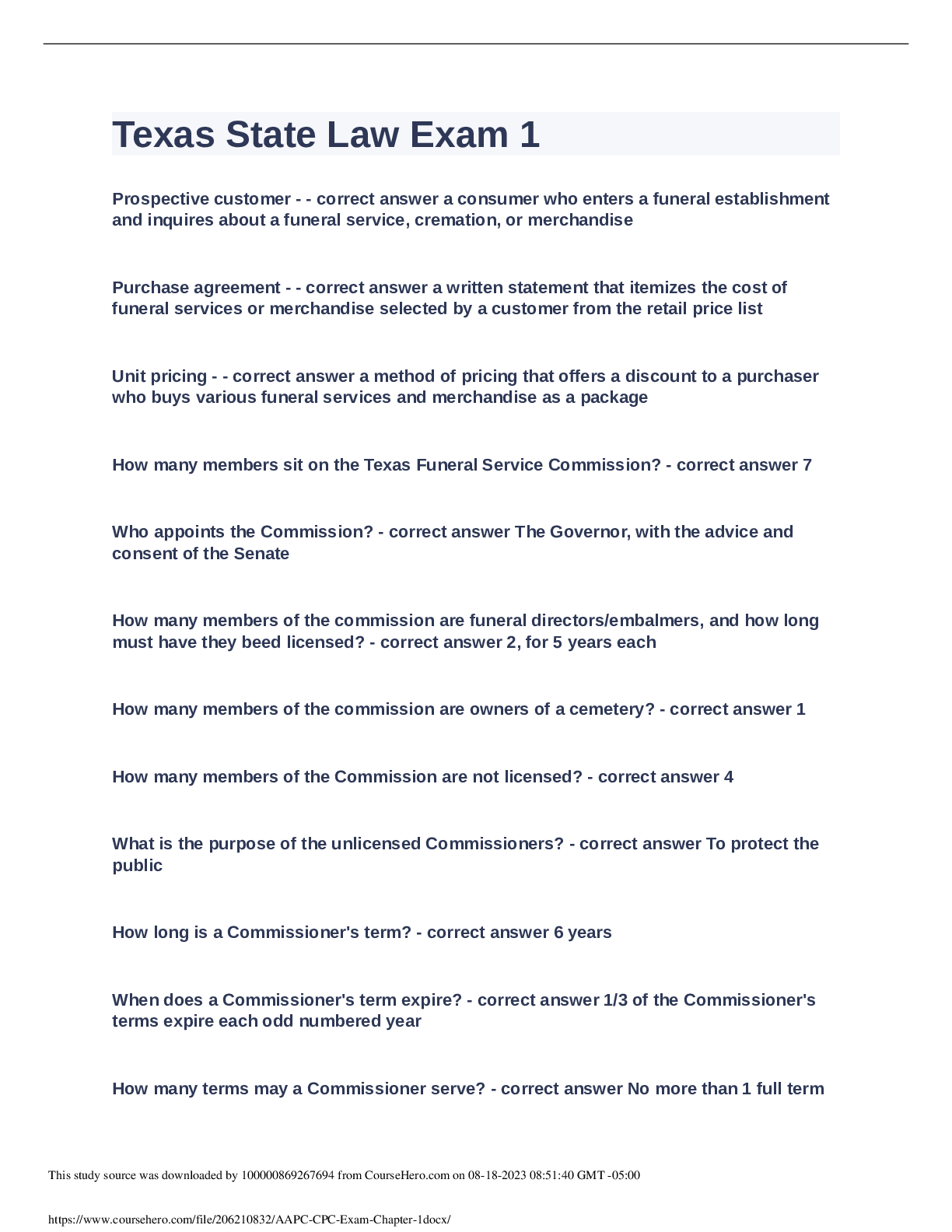
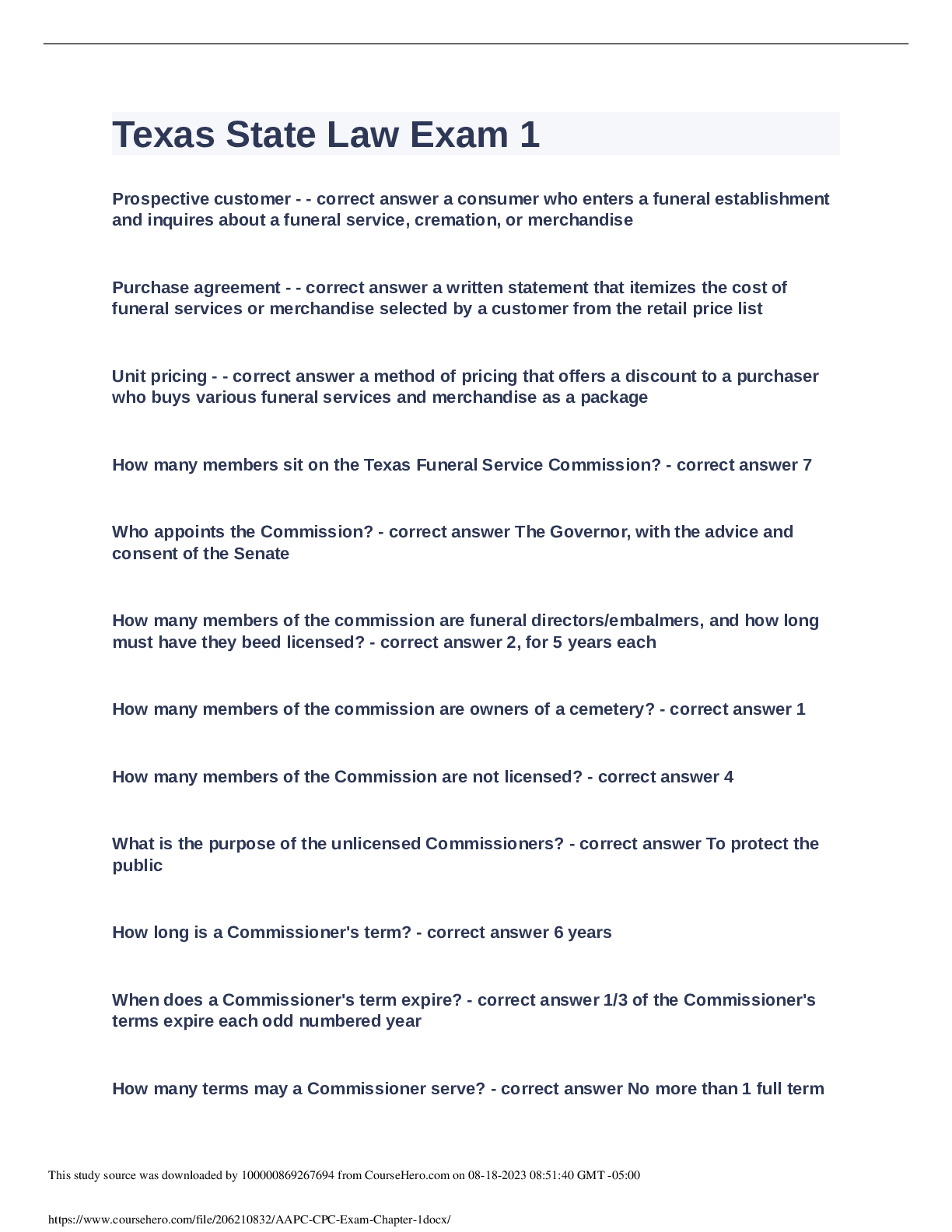
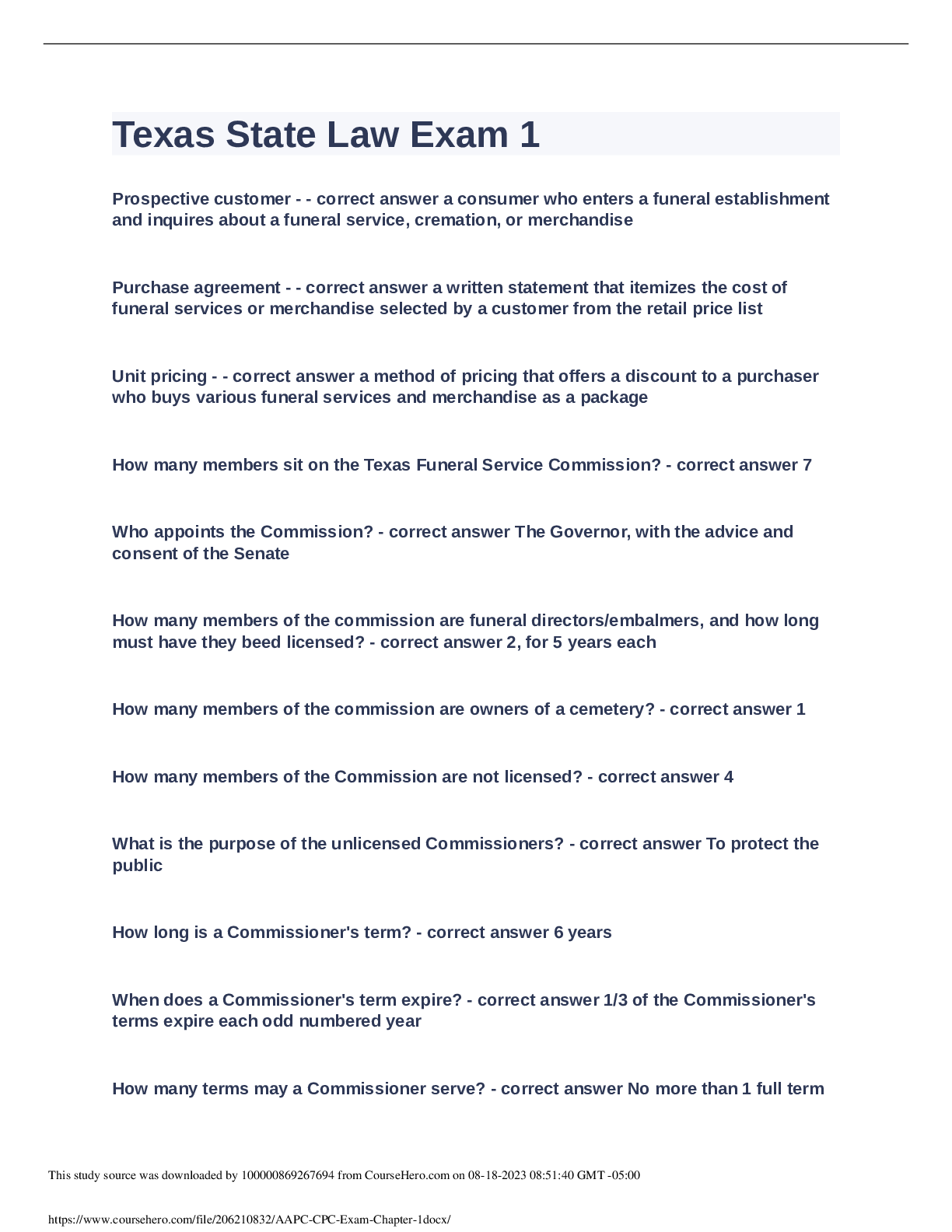
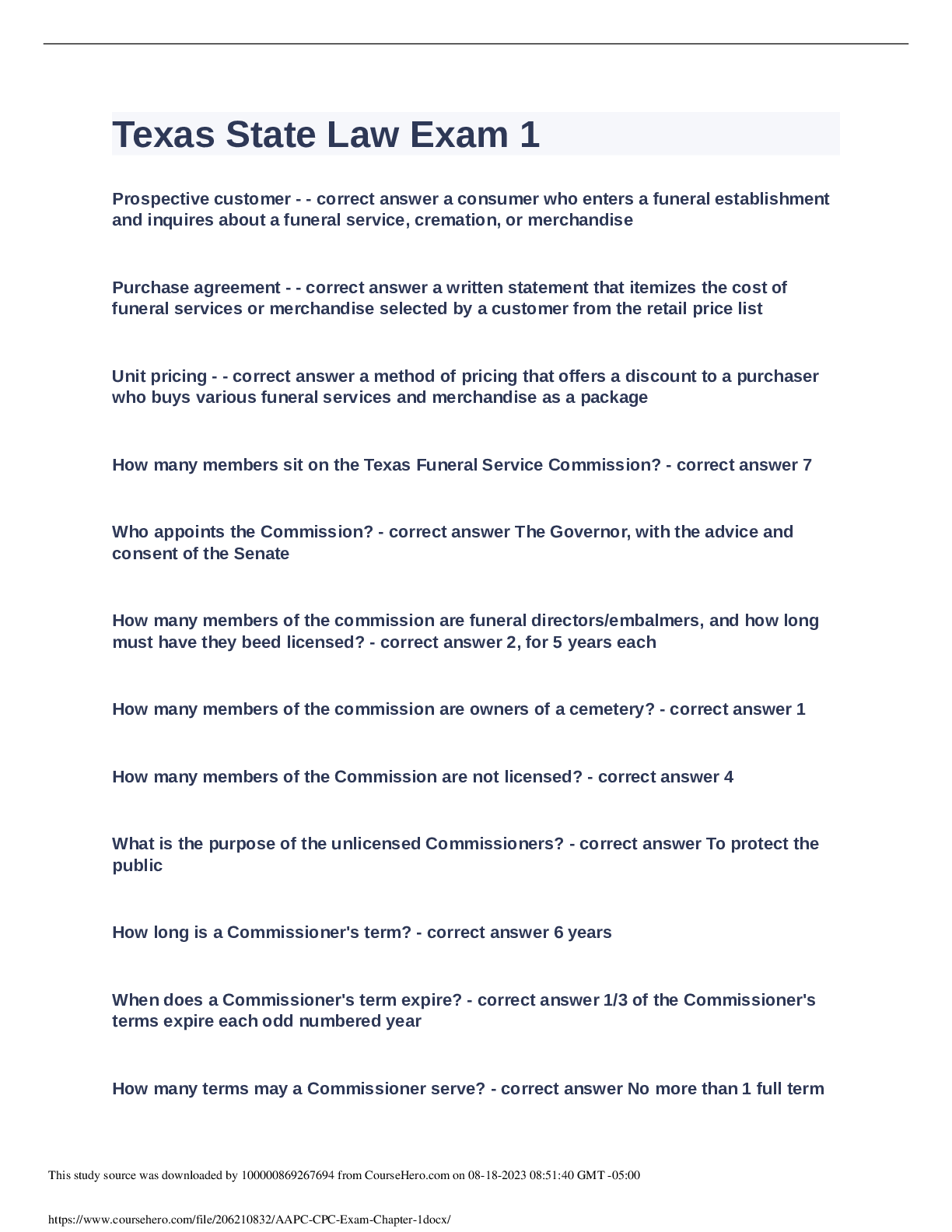
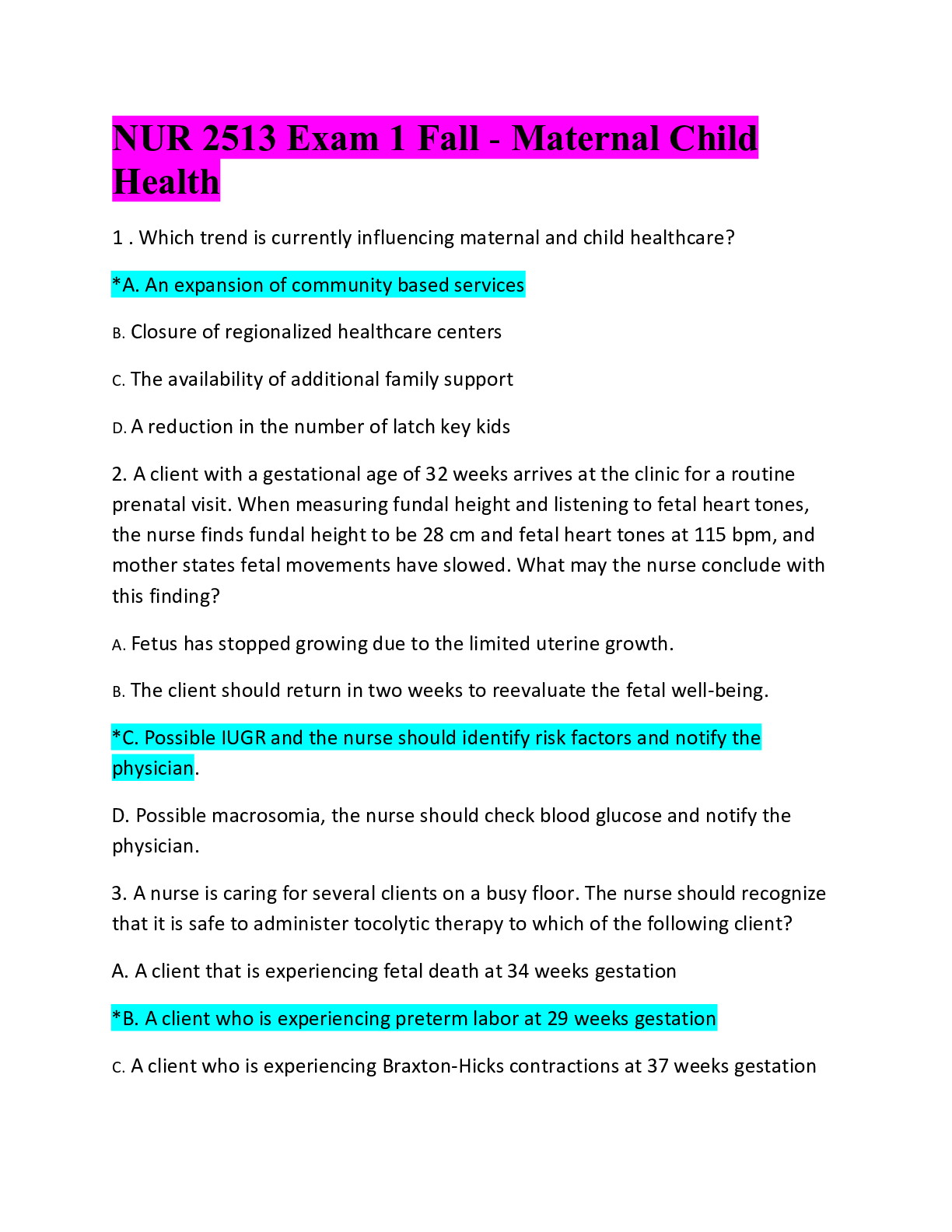


.png)
